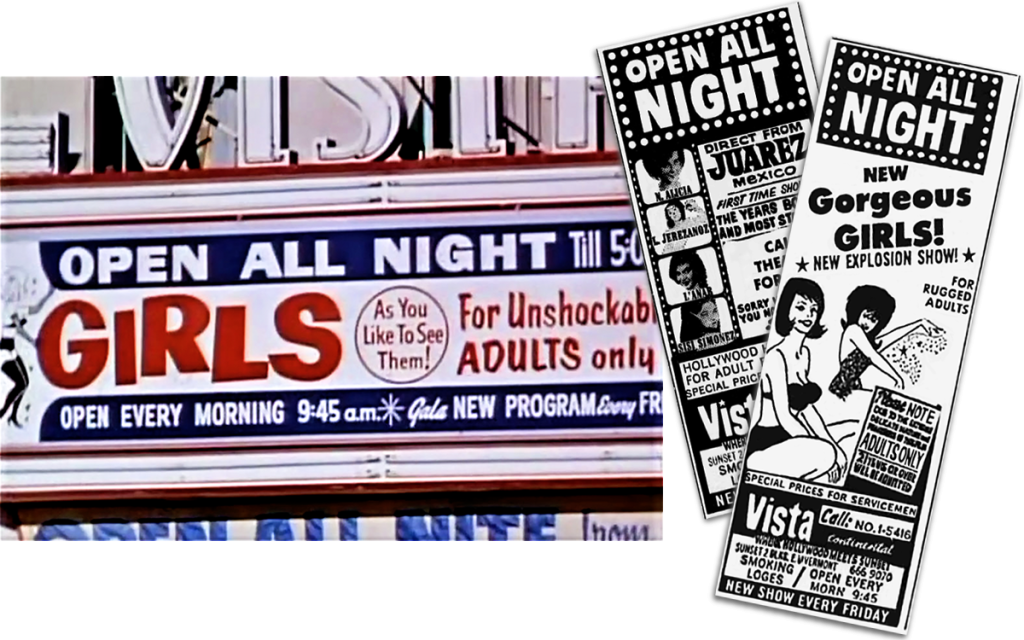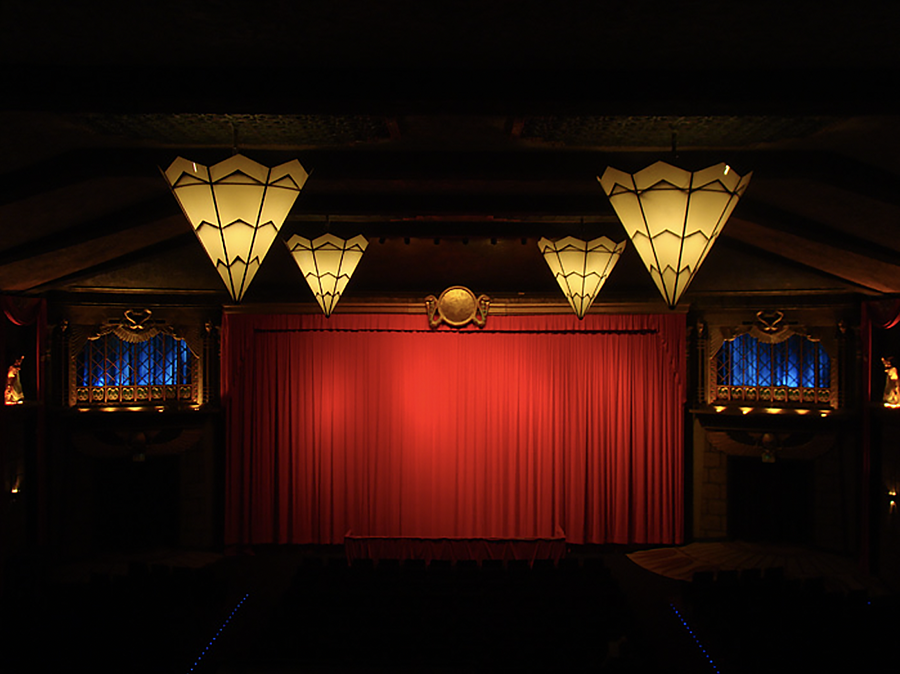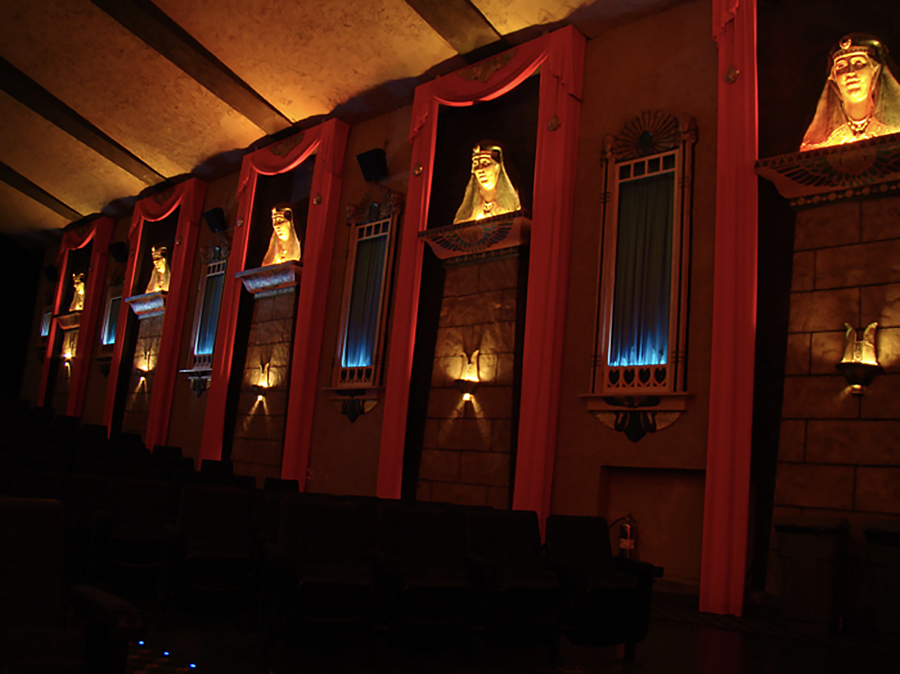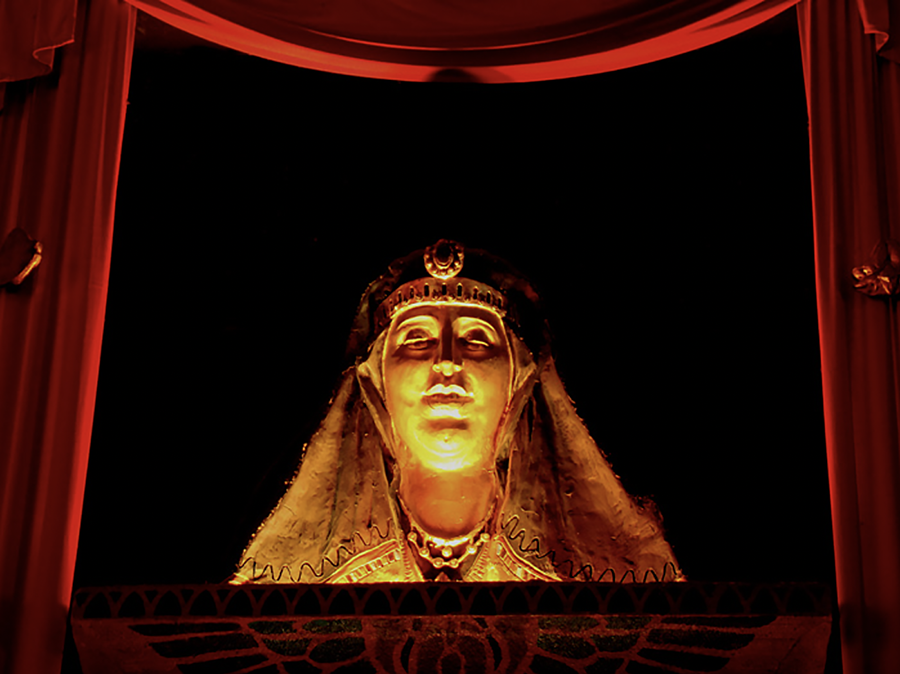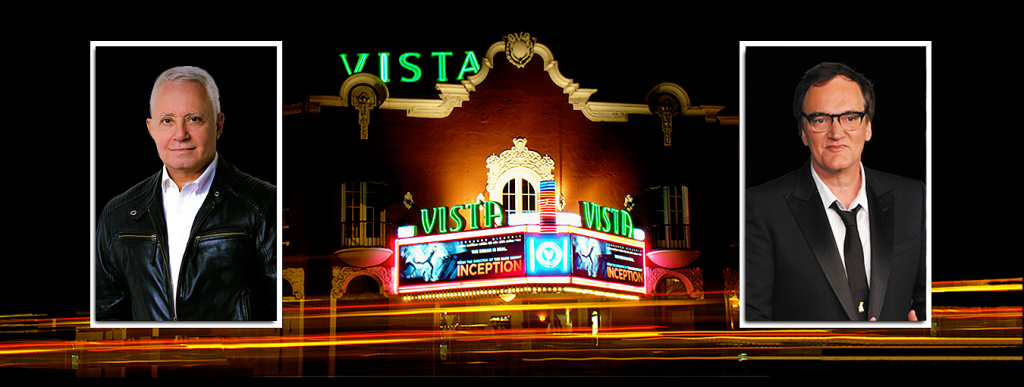
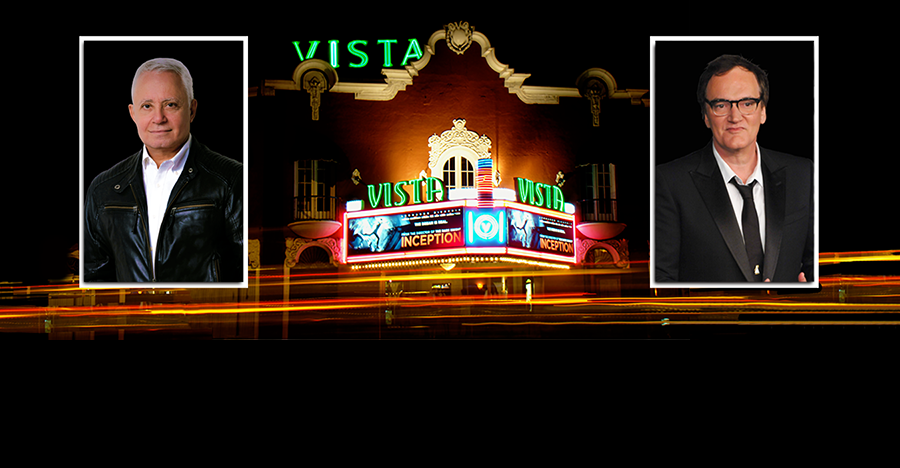
Flipping Quentin’s Vista
Flipping Quentin’s Vista
theater photos courtesy Lance Alspaugh,
the Vista Theatre
EXCLUSIVE | Legendary filmmaker Quentin Tarantino and private-cinema maestro Theo Kalomirakis join up to transform a neighborhood hangout into an international film-lover’s destination
by Michael Gaughn
July 29, 2022
Building a movie theater on the dirt lot where D.W. Griffith shot the massive Walls of Babylon sets for his once revered now reviled silent-movie epic Intolerance is kind of like building on an old Indian burial ground. And yet that’s where LA’s Vista Theatre rests, and it’s hard not to
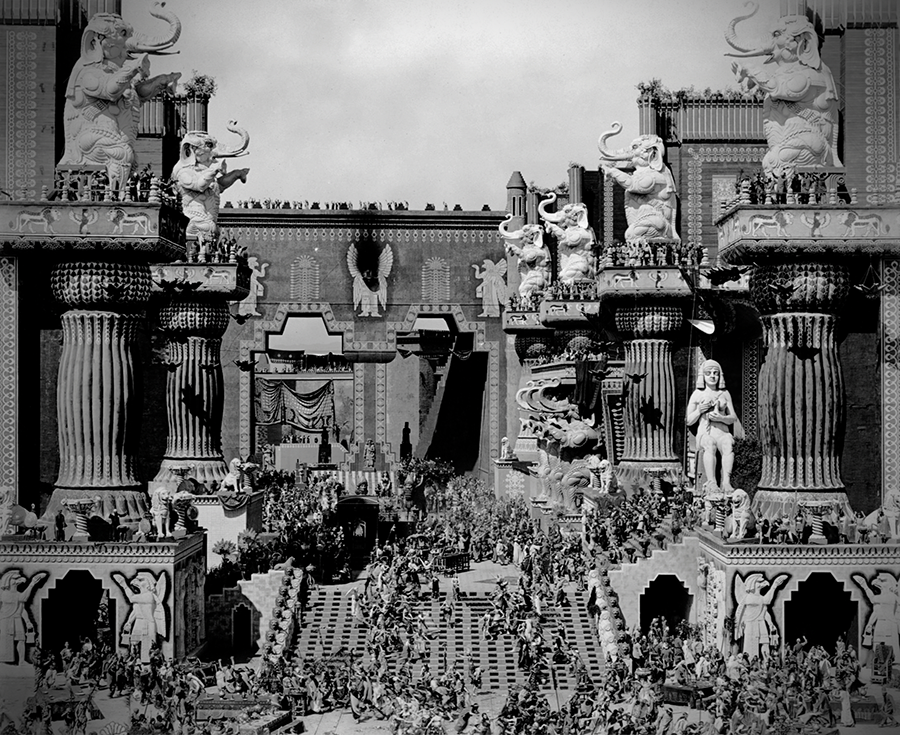
sense the presence of silent movies past—and of a whole alternative, and slightly unsavory, history of Hollywood—emanating from it like a wraith.
The Vista has been through a lot. Originally christened the Lou Bard Playhouse and offering both live performances and movies, its premiere screening in 1923 featured the biggest child star of the day, the now forgotten Baby Peggy. Assuming its current name
c. 1930, the theater became something of a changeling, for a while showing first-run films, then second-run, foreign, and classic, during the ‘60s dabbling in some very adult burlesque, and, for an extended stretch, soft then hardcore porn.
After a brief stint as a revival house, the
The Vista has been through a lot. Originally christened the Lou Bard Playhouse and offering both live performances and movies, its premiere screening in 1923 featured the biggest child star of the day, the now forgotten Baby Peggy. Assuming its current name c. 1930, the theater became something of a changeling, for a while showing first-run films, then second-run, foreign, and classic, during the ‘60s dabbling in some very adult burlesque, and, for an extended stretch, soft then hardcore porn.
Vista transitioned back to first-run in the mid ‘80s, but thanks to midnight screenings, a steady flow of special events and premieres, cameos in films like True Romance and The Swinger, and the lingering reputation of its shapeshifter past, it’s become a magnet for independent, cult, and B movies and other manifestations of alt. The sidewalk beneath its marquee is pitted with celebrity handprints à la Grauman’s Chinese. You won’t find any Cary Grants or Steve McQueens there, though, but Bud Cort, Kenneth Anger,
After a brief stint as a revival house, it transitioned back to first-run in the mid ‘80s, but thanks to midnight screenings, a steady flow of special events and premieres, cameos in films like True Romance and The Swinger, and the lingering reputation of its shapeshifter past, it’s become a magnet for independent, cult, and B movies and other manifestations of alt. The sidewalk beneath its marquee is pitted with celebrity handprints à la Grauman’s Chinese. You won’t find any Cary Grants or Steve McQueens there, though, but Roger Corman, Bud Cort, Ray Harryhausen, Kenneth Anger, and the cast of Dark Shadows instead.
So it’s not hard to see why the Vista might catch Quentin Tarantino’s eye. A patron for years, Tarantino came to resonate so strongly with the theater’s vibe that he decided to snatch it up, freshen it up a bit, and see if he couldn’t turn it into a must-see destination for rabid film nerds like himself.
Ray Harryhausen, and the cast of Dark Shadows instead.
So it’s not hard to see why the Vista might catch Quentin Tarantino’s eye. A patron for years, Tarantino came to resonate so strongly with the theater’s vibe that he decided to snatch it up, freshen it up a bit, and see if he couldn’t turn it into a must-see destination for rabid film nerds like himself.
His affection for the Vista seems to
spring as much from what it’s not as from what it is. It’s not an opulent movie palace like Disney’s flagship El Capitan 11 miles down the road but a kind of mini palace with a neighborhood-hangout feel. And it’s not located in the heart of Hollywood, like the El Capitan, Grauman’s, Pantages, or Cinerama Dome, but in a nebulous no-man’s land tucked between Los Feliz, Silver Lake, and, just down Sunset Blvd., Little Armenia. It might be wry but not wrong to think of the Vista as the brick & mortar equivalent of the defiant outsider, the unbowed survivor.
It’s a little harder to understand the theater’s attraction for designer Theo Kalomirakis, whose reputation rests largely on bringing exuberant flair, tempered by tasteful restraint, to creating private cinemas, a category of design that too easily and often descends into excess and kitsch in the hands of others. But much of the Vista, from its iron-maiden-like box office to its well-intended stabs at hieroglyphics to its looming Nile-Delta-by-way-of-Topeka pharaohs, is pretty much an altar to kitsch.
His affection for the Vista seems to spring as much from what it’s not as from what it is. It’s not an opulent movie palace like Disney’s flagship El Capitan 11 miles down the road but a kind of mini palace with a neighborhood-hangout feel. And it’s not located in the heart of Hollywood, like the El Capitan, Grauman’s, Pantages, or Cinerama Dome, but in a nebulous no-man’s land tucked between Los Feliz, Silver Lake, and, just down Sunset Blvd., Little Armenia. It might be wry but not wrong to think of the Vista as the brick & mortar equivalent of the defiant outsider, the unbowed survivor.
It’s a little harder to understand the theater’s attraction for designer Theo Kalomirakis, whose reputation rests largely on bringing exuberant flair, tempered by tasteful restraint, to creating private cinemas, a category of design that too easily and often descends into excess and kitsch in the hands of others. But much of the Vista, from its iron-maiden-like box office to its well-intended stabs at hieroglyphics to its looming Nile-Delta-by-way-of-Topeka pharaohs, is pretty much an altar to kitsch.
above | the auditorium, designed in an Egyptian style meant to reflect the Vista’s Intolerance roots, will be kept pretty much as is
It’s not like Kalomirakis even knew the Vista existed before he took on the assignment of translating Tarantino’s wishes into a satisfying reality. His involvement is due mainly to some deft but determined bird-dogging by the previous owner, Lance Alspaugh, who’s been retained to manage the theater and shepherd the renovation. A devotee of Kalomirakis’ work, Alspaugh slipped a copy of Private Theaters, the sumptuous coffeetable-book presentation of the designer’s early efforts, in front of Tarantino at a planning meeting.
As Tarantino flipped through the book, Alspaugh started making the case for retaining Kalomirakis but quickly realized he could save his breath. It was clear from Tarantino’s expression he was hooked. “We don’t really need to talk about this anymore,” he said. “This is obviously the guy.”
Kalomirakis politely declined the first time Alspaugh called—and the second, and the third. Content with the life he’s carved out for himself since moving back to Greece, Kalomirakis was taking on few new projects; plus, his experience with commercial theaters is limited. But, adopting the same tactics he deployed to convince famed designer Joseph Musil, who had renovated the El Capitan, to flip Coronado’s Village theater, Alspaugh quietly persisted, with his gentle persuasion eventually winning Kalomirakis over.
The Theo/Quentin honeymoon proved short-lived, though. Having been told the plan was to leave the Vista’s auditorium pretty much as is, Kalomirakis assumed his mandate was to do the rest of the theater in the same Egyptian Deco style. And although Tarantino liked Kalomirakis’ initial design, he ultimately deemed it too elegant, coming back with suggestions for faux cinderblock walls and an outsized RC Cola
It’s not like Kalomirakis even knew the Vista existed before he took on the assignment of translating Tarantino’s wishes into a satisfying reality. His involvement is due mainly to some deft but determined bird-dogging by the previous owner, Lance Alspaugh, who’s been retained to manage the theater and shepherd the renovation. A devotee of Kalomirakis’ work, Alspaugh slipped a copy of Private Theaters, the sumptuous coffeetable-book presentation of the designer’s early efforts, in front of Tarantino at a planning meeting.
As Tarantino flipped through the book, Alspaugh started making the case for retaining Kalomirakis but quickly realized he could save his breath. It was clear from Tarantino’s expression he was hooked. “We don’t really need to talk about this anymore,” he said. “This is obviously the guy.”
Kalomirakis politely declined the first time Alspaugh called—and the second, and the third. Content with the life he’s carved out for himself since moving back to Greece, Kalomirakis was taking on few new projects; plus, his experience with commercial theaters is limited. But, adopting the same tactics he deployed to convince famed designer Joseph Musil, who had renovated the El Capitan, to flip Coronado’s Village theater, Alspaugh quietly persisted, with his gentle persuasion eventually winning Kalomirakis over.
The Theo/Quentin honeymoon ended up being brief, though. Having been told the plan was to leave the Vista’s auditorium pretty much as is, Kalomirakis assumed his mandate was to do the rest of the theater in the same Egyptian Deco style. And although Tarantino liked Kalomirakis’ initial design, he ultimately deemed it too elegant, coming back with suggestions for faux cinderblock walls and an outsized RC Cola dispenser that would overwhelm what Kalomirakis had in mind for the concession stand. (There’s even talk of a Mold-a-Rama.)
It wasn’t until Kalomirakis heard about the decidedly casual grunge-ish look planned for the coffeeshop and gaming arcade that will occupy the storefronts to either side of the Vista that he got where Tarantino’s trying to go. Not wanting the theater to feel so exclusive that anyone hesitates to enter, Tarantino instead wants to create an everyman’s retreat that evokes his own early experiences of going to the movies.
dispenser that would overwhelm what Kalomirakis had in mind for the concession stand. (There’s even talk of a Mold-a-Rama.)
It wasn’t until Kalomirakis heard about the decidedly casual grunge-ish look planned for the coffeeshop and gaming arcade that will occupy the storefronts to either side of the Vista that he got where Tarantino’s trying to go. Not wanting the theater to feel so exclusive that anyone hesitates to enter, Tarantino instead wants to create an everyman’s retreat that evokes his own early experiences of going to the movies.
That realization was a revelation for Kalomirakis. The common bond between him and Tarantino, it turns out, is exactly that intense love, born in childhood, for the whole experience of watching movies—a shared origin story that runs so deep it’s been the inspiration, and constant source of sustenance, for both of their careers. Seeing that Tarantino was more interested in staying true to his emotional roots than to the bones of the Vista gave Kalomirakis a new and more potent source of inspiration to draw on.
Embracing that come-one-come-all, come-as-you-are dynamic, Kalomirakis quickly created a new design that Tarantino just as

quickly blessed—which is a good thing since the renovation is already well under way, with the lobby already gutted. Early, likely optimistic, estimates pointed toward a December reopening; early to mid 2023 is looking more realistic.
But there’s a whole other layer to this story, one that’s been all but lost in all the attention paid to the acquisition and renovation. That Tarantino is having the projection booth rebuilt to accommodate his personal dual-format 35mm/70mm projectors isn’t too surprising given his well-known preference for film over digital. But what might get the savvy to sit up and take note are his plans to show first-run movies on film, having prints struck even for titles pegged for digital-only release—which is of course damn near everything.
To that end, Tarantino has formed a kind of cabal with other movies-on-film fans like Christopher Nolan, Paul Thomas Anderson, and Judd Apatow, with this formidable band of insiders pooling its resources to get prints made and help put the Vista firmly on the radar of the film-forever crowd. Since probably no one but Tarantino has the necessary sway and determination to pull something like this off, it seems likely the Vista reborn will be—and remain—one of a kind.
It’s obvious Tarantino’s Vista isn’t going to be just some neighborhood haunt or famous filmmaker’s vanity project but, in its unassuming way, a mecca, an off-the-beaten-path everyone’s-invited celebration of the movies, a unique night out for anyone seeking a new old way to see the latest fare on film.
Michael Gaughn—The Absolute Sound, The Perfect Vision, Wideband, Stereo Review, Sound & Vision, The Rayva Roundtable, marketing, product design, some theater designs, a couple TV shows, some commercials, and now this.
© 2025 Cineluxe LLC


